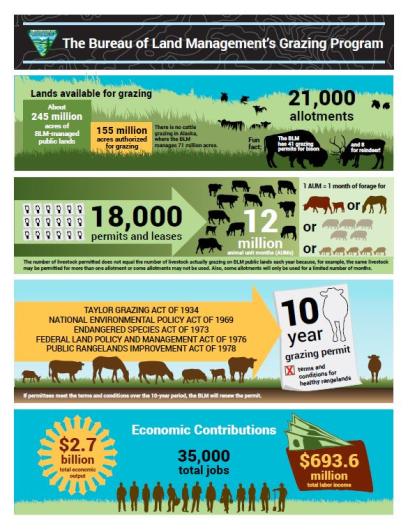
Livestock Grazing on Public Lands
The BLM manages livestock grazing on 155 million acres of public lands. The terms and conditions for grazing on BLM-managed lands (such as stipulations on forage use and season of use) are set forth in the permits and leases that we issue to public land ranchers.
The BLM administers nearly 18,000 permits and leases held by ranchers who graze their livestock, mostly cattle and sheep, at least part of the year on more than 21,000 allotments. Permits and leases generally cover a 10-year period and are renewable if the BLM determines that the terms and conditions of the expiring permit or lease are being met. The amount of grazing that takes place each year on BLM-managed public lands can be affected by such factors as drought, wildfire, and market conditions.
- Outcome-Based Grazing Authorizations
-
In September 2017, the BLM’s Division of Rangeland Resources announced an initiative known as Outcome-Based Grazing Authorizations (OBGAs). It is designed to offer a more collaborative approach between the BLM and its partners within the livestock grazing community when issuing grazing authorizations.
The purpose of this project is to improve management of grazing on public lands by offering livestock operators greater flexibility to more readily respond to changing on-the-ground conditions, such as drought or wildfire. This will better ensure their ability to manage ranching operations that are economically sustainable while also providing for healthy rangelands and high-quality wildlife habitat. Decreasing the response time to changing field conditions is one of the primary goals of the demonstration project. The program highlights BLM’s commitment to partnerships, which are vital to managing sustainable, working public lands.
Through this joint effort with authorization holders, the BLM hopes to more efficiently achieve identified resource, habitat and operational objectives. These authorizations will prescribe a joint management approach, whereby both public and private lands are managed together with joint responsibility.
The BLM and its partners will not only share the responsibility for reaching their mutual objectives of this project, but also for monitoring its success.
In March 2018, BLM selected 11 demonstration projects in six states, with a variety of conditions and circumstances. The BLM will consider the success of these projects when crafting guidance and best management practices for future grazing authorizations.
Links:
- The Need for Flexibility: Exploring Innovation in a Public Land Grazing System
- BLM announces outcome-based grazing authorization demonstration projects for 2018
- Outcome-Based Grazing demonstration projects map
- BLM offers livestock operators increased flexibility through outcome-based grazing authorizations
- Fees and Distribution
-
In Fiscal Year 2015, the BLM was allocated $79 million for its rangeland management program. Of that figure, the agency spent $36.2 million, or 46 percent, on livestock grazing administration. The other funds covered such activities as weed management, rangeland monitoring, planning, water development, vegetation restoration, and habitat improvement. In 2015, the BLM collected $14.5 million in grazing fees. The receipts from these annual fees, in accordance with legislative requirements, are shared with state and local governments.
The federal grazing fee is adjusted annually and is calculated by using a formula originally set by Congress in the Public Rangelands Improvement Act of 1978. Under this formula, the grazing fee cannot fall below $1.35 per animal unit month (AUM); also, any fee increase or decrease cannot exceed 25 percent of the previous year’s level. An AUM is the amount of forage needed to sustain one cow and her calf, one horse, or five sheep or goats for a month. The grazing fee for 2019 is $1.35 per AUM, as compared to the 2018 fee of $1.41 per AUM.
The grazing fee applies to federal lands in 16 Western states on public lands managed by the BLM and the U.S. Forest Service.
- Permits
-
Any U.S. citizen or validly licensed business can apply for a BLM grazing permit or lease. To do so, one must either:
- Buy or control private property known as base property (property that has been legally recognized by the BLM as having preference for the use of public land grazing privileges), or
- Acquire property that has the capability to serve as base property and then apply to the BLM to transfer the preference for grazing privileges from an existing base property to the acquired property (this would become the new base property).
Before buying or leasing ranch property, you should contact the local BLM field office.
The BLM has information on the status of the grazing privileges attached to the base property, including the terms and conditions of the associated grazing permit or lease that authorizes the use of those privileges and other important information. All applicants for grazing permits or leases must meet the qualifications for public land grazing privileges that are specified in the BLM’s grazing regulations.
- Range Improvements
-
There are two kinds of range improvements: nonstructural and structural. Seedings or prescribed burns are examples of nonstructural range improvements. Fences or facilities, such as wells or water pipelines, are examples of structural improvements.
Many structural improvements are considered permanent, as they are not easily removed from the land. Such improvements enhance livestock grazing management, improve watershed conditions, enhance wildlife habitat, or serve similar purposes.

